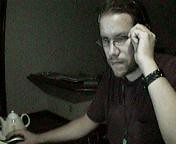An artist, particularly a visual one, is something I am particularly proud of being. This is not a pride proportional to my talent, as a pride of achievement is, but a pride that is a little more involved. This may be because of my approach, and may be because I am dissatisfied with my current skill, but believe my progress is sufficient to reach a level satisfactory to such a pride. I am not certain.
Artistry, unfortunately, is usually approached in an intellectual manner with more pretension than skill, and certainly more holism than reductionism. Which leads to unbalanced big theories of artistry that center around the artist being a mutant genius afloat in a sea of experience among the morons and pharisees, inevitably.(If that sentence didn't resonate with you, you haven't read much art theory or worldview statements by artists)
The big issue with Art is communication. It's a transmissive medium, as I see it, and it's purpose is dirtied otherwise. The largest technical issue with making art, is icons, and your mind's predilectation for making them. For example, when you see a tree, rarely do you conciously explore it's details, edges, proportions, and colours. You rather, measure the tree in a basic and self-impactful way, and replace it in your map of the area with a simplified version based on your basic icon for a tree. Which is why when children start drawing, they invariably start with stick figures and similar. Their internal icons are very simple, and almost universal. Autistic children, lacking some higher-order integrative faculties, often are 'good' artists, because they sit and regurgitate details, forming complex pictures from memories. dwelling on details, rather than icons significant to themselves.
The problem is that our internal models rarely interact with other people or even ourselves. To combat being a bad artist in this way, you have two choices. You can force yourself to notice detail, proportion, and line, as a concious-level process, while you make art. This is a reciprocating process, where you duplicate detail, check your art, duplicate another detail, and so on. The other route, which almost all artists do, conciously or not, is to increase the detail level of your internal models of things you see. The more you do art, the more you will notice detail, until you hold your personal limit of visual detail without overloading your working memory. Very good artists often start with very complex internal visual models, others develop them through practice. Both approaches are valid, and both are usually pursued by artists, to varying degrees of reliance and skill. The mechanics of pen, brush, stylus, claymould, and blowtorch control are largely incidental and handled by specialized parts of your brain that everybody has anyway. Artistic talent is largely that of model complexity, and mental techniques for complexity management.
The really tricky bit is then taking the talent, and moving it to an art piece. This largely involves reverse-engineering the detail and line of the displayed object, and re-inserting your removed iconography and emotional subtext, without destroying the integrity of the picture, balancing detail and abstraction in an effort to both resonate and be recognized. The visual mediums have their own vocabulary, and it is within your choices as an artist, to determine which vocabularies you use. Realistic Art uses the terms and icons all are familiar with, objects and people, all close within normative reality, limiting the amount of icon work, and subtext you may insert. Abstract art often takes advantage of vocabularies not everyone has, limiting the potential audience, and how specific you can be, but allowing far more subtext and iconography to be inserted.
Artistic quality of a specific piece is a separate notion entirely, and rest on too many factors for me to lay bare. If I do get any closer to doing so personally, you'll be the first to know.
I've used iconography and several other words recklessly and outside their usual definitions, for this I apologise, and I promise I'm not a pretensetic artist with a tendency for neologisms, just a hapless prole at a librarium without a thesaral reference.

No comments:
Post a Comment